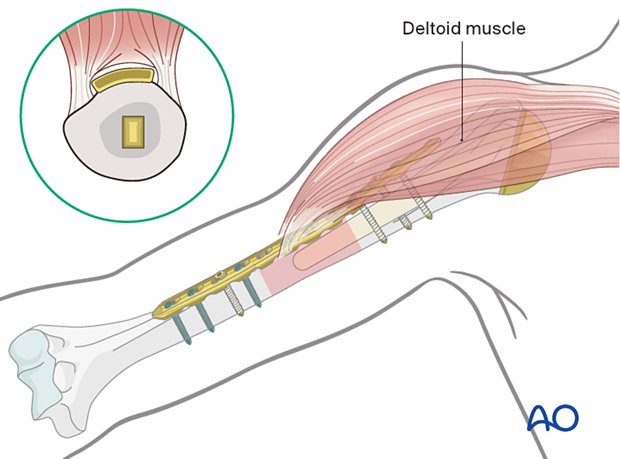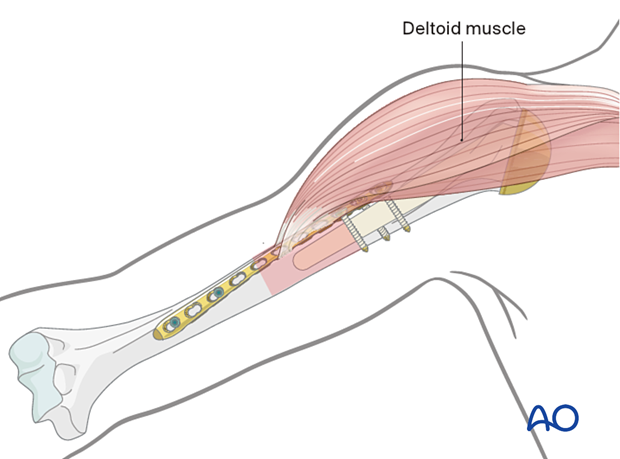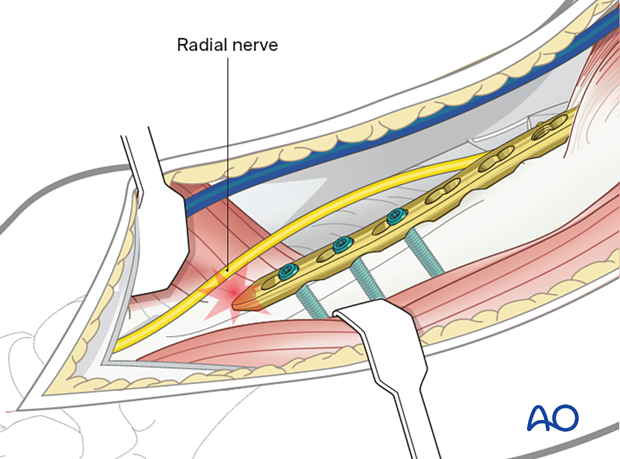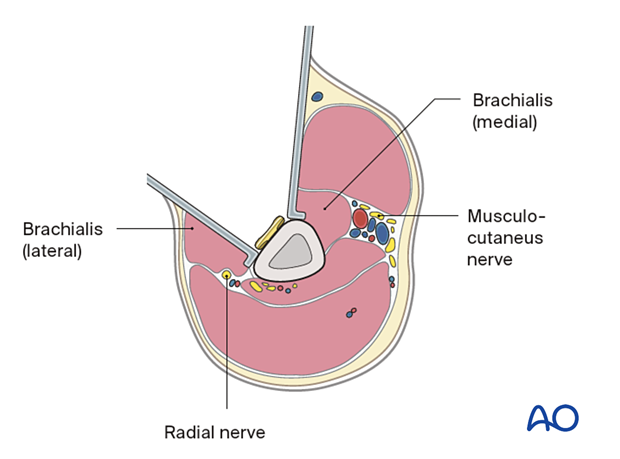ORIF - Bridge plate fixation
1. Principles
Bridge plating
Bridge plating uses the plate as an extramedullary splint, fixed to the two main fragments, while the intermediate fracture zone is left untouched. The aim is anatomic alignment of the bone, whereas anatomic reduction of the shaft fragments is not necessary. Furthermore, direct manipulation risks disturbing the blood supply. If the soft-tissue attachments are preserved, and the fragments are relatively well aligned, healing is predictable.
Reduction can usually be achieved indirectly using distraction.
Mechanical stability, provided by the bridging plate, is adequate for indirect healing (callus formation). Occasionally, a larger wedge fragment might be approximated to the main fragments.

Bridge plate insertion
With open bridge plating, it is important to preserve soft-tissue attachments to the fracture fragments. To do this, stable provisional reduction, and minimal exposure and manipulation of the fracture zone are important.
2. Choice of implant
Plate types
The following plate types may be used depending on the fracture location or configuration:
- Standard plate 3.5 mm or 4.5 mm system
- Plate with locking head screws (LCP)
- Anatomically pre-contoured plate
- Extraarticular distal humerus plate

3. Plate position
Introduction
The choice of plate position depends on the fracture morphology and location and is influenced by the presence of radial nerve pathology. The anterolateral, anterior, and posterior surfaces of the humeral shaft are all possible choices.

Anterolateral or anterior plate
An anterolateral plate fits well from very proximally to the distal fifth of the humerus and can be selected if proximal and middle third fractures are present.
A plate in this position should provide stable fixation of the fracture and minimal soft-tissue damage.
Proximally, the plate may interfere with the deltoid insertion if it is placed laterally. To overcome this problem the proximal end of the plate can be tunneled through the deltoid insertion.

Distally the plate may be applied to the anterior or lateral surface.


The innervation of the brachialis muscle is derived from both the radial and musculocutaneous nerves. The radial branch is at risk if the plate is applied to the anterior and anterolateral surfaces in the distal third of the humerus while retracting the entire brachialis muscle medially. To avoid this, it is safer to split the brachialis muscle.

Posterior plate
The posterior surface is difficult to access proximally and limited by the axillary nerve. Therefore, posterior plating is best suited for middle and distal third fractures of the humerus.
It is important to protect the radial nerve and its accompanying vessels in the spiral groove. If the plate interferes with the radial nerve, the plate must be placed underneath it.

4. Patient preparation and approaches
Patient positioning
Place the patient in a beach chair position at 30°. The arm is supported on a side table.
For more distal fractures, the patient is placed in a lateral decubitus position. A prone position can also be used.
Patient positioning should be discussed with the anesthetist.
Approaches
The approach is selected depending on the chosen plate position.
For an anterolateral plate a deltopectoral approach with extension may be used.
The posterior surface can be accessed with a posterior humeral approach.
5. Reduction
The aim is to restore axial alignment and rotation. Shortening of 1 cm or 2 cm may be acceptable in the humerus, and with extreme fragmentation may improve bone contact.

Standard reduction techniques of the humerus are provided in the Surgery Reference adult trauma Humeral shaft module.
Comminuted fragments
Alignment of comminuted fragments does not need to be anatomical. Manipulation of fragments with poor soft-tissue attachments puts their blood supply at risk.
Generally, soft-tissue attachments will bring these fragments into appropriate positions as the proximal and distal portions of the humerus are brought into correct alignment and fixed.
Occasionally, screws or cerclage sutures can be used to improve fracture fragment approximation. This option should be considered if important tendon insertions or major fragments are still displaced. In these instances, better fracture alignment may help to improve later clinical function and healing.

6. Plate application
More information on bridging plates is provided in the Plating basic technique and the Surgery Reference adult trauma Humeral shaft module.

Where possible, standard plate and screw fixation techniques are used.
In the peri-implant area standard screw application may be jeopardized by the presence of the stem. In this situation, the following techniques may be used:
- Off-axis screws on either side of the implant
- Unicortical screws with cerclage cables/wires
- Locking attachment plate
Further details on peri-implant plate fixation are provided here.

7. Aftercare
Postoperative phases
The aftercare can be divided into four phases of healing:
- Inflammatory phase (week 1–3)
- Early repair phase (week 4–6)
- Late repair and early tissue remodeling phase (week 7–12)
- Remodeling and reintegration phase (week 13 onwards)
Full details on each phase can be found here.













